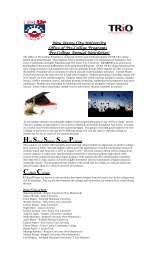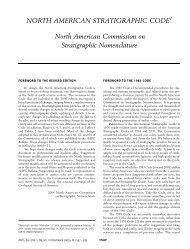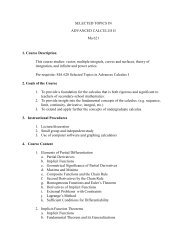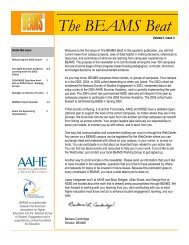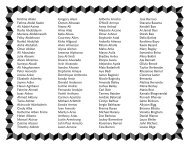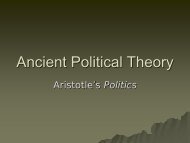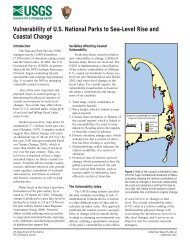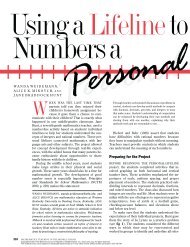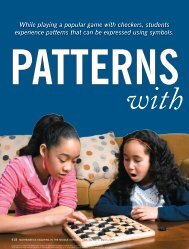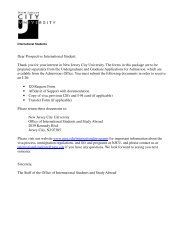Increasingnumbers ofteachers useliterature <strong>to</strong>teach mathThe Value of <strong>Literature</strong> in <strong>Teach</strong>ingMathematicsHISTORICALLY, EDUCATION IN THE UNITEDStates has been driven by a single-textbook mentality,especially at the middle and high school levels.<strong>Teach</strong>ers have relied primarily, if not exclusively,on single textbooks as the basis for content-area instruction.Recently, however, increasing numbersof teachers are being asked <strong>to</strong> teach reading andtheir content areas at the same time. Mathematicsteachers are no exception. Like other content-areateachers, mathematics teachers realize that oneway <strong>to</strong> cover both reading and another subject is <strong>to</strong>move from using a single textbook <strong>to</strong> working withmultiple textbooks. Recent research in elementaryschool reading instruction indicates that studentsbenefit from teachers who make this shift (Goodman1998). Students whose teachers used multipletextbooks showed higher mean scores on the NationalAssessment of Educational Progress (NAEP)than did students whose teachers were using onlysingle textbooks (Mullis et al. 1993a, 1993b; Campbellet al. 1996; Miller et al. 1995; Williams 1995).These results have important implicationsfor middle school teachers.In light of these findings, a number ofquestions arise: How can middleschool teachers build on students’ elementaryschool experiences andsuccesses with multiple textbooks incontent-area instruction? How canmiddle school mathematics teachersuse literature <strong>to</strong> teach importantmathematical concepts?<strong>Using</strong> <strong>Literature</strong> <strong>to</strong> <strong>Teach</strong> Fac<strong>to</strong>rialsRECENTLY, WE OBSERVED A LESSON CONductedby a sixth-grade mathematics teacher in arural public school. The teacher was working withstudents on a lesson titled “Understanding MathematicalChange Concepts” (Kentucky Core Content1999). She wanted students <strong>to</strong> be able <strong>to</strong> (1) recognize,create, and expand patterns in the real world;(2) represent patterns in several ways (e.g., graphs,ordered pairs, verbal statements, and algebraicrules); and (3) investigate patterns in number sequencesand relate them <strong>to</strong> real-world experiences.The teacher began the lesson with the followingintroduction:Today we’re going <strong>to</strong> have some fun with mathematics.Now, if you’re like my son, you like icecream. The other night, I <strong>to</strong>ok my son <strong>to</strong> get anice-cream cone. We went in<strong>to</strong> the s<strong>to</strong>re and sawa group of children standing at the counter trying<strong>to</strong> order their cones. Their orders <strong>to</strong>ok moretime than they should have because the childrenkept arguing about who would get <strong>to</strong> order first.Later, their argument made me think of anotherproblem I read some time ago. Here it is; see ifyou can figure it out. [The teacher turned on theoverhead projec<strong>to</strong>r, and the following word problemwas written on a transparency.]Situation: Suppose you and three friends go in<strong>to</strong>an ice-cream s<strong>to</strong>re for cones. “Who’s first?” the personbehind the counter might ask. When the firstindividual has received a cone, the counterpersonwould most likely ask, “Who’s next?” How many differentpossibilities can you think of for you andyour friends <strong>to</strong> be first, second, third, or fourth? Inother words, in how many different ways could thefour of you line up?”The teacher then stated, “Work with a friend, andtake a few minutes <strong>to</strong> see if you can solve this problem.”Students immediately started <strong>to</strong> talk with oneanother. After about ten <strong>to</strong> fifteen minutes, theteacher asked students <strong>to</strong> share their answers and explanationsabout how they solved the problem. Onepair of students said that the answer was 16, and severalothers agreed. Other pairs said that the answerwas 24. Still others’ answers included 32, 64, and 256.For example, Jennifer said, “At the beginning weweren’t sure how <strong>to</strong> solve this problem, and we’re stillnot sure, but we think it’s 16. Here’s how we did it:We went 1, 2, 3, 4; then 2, 3, 4, 1; then 3, 4, 1, 2; and finally,4, 1, 2, 3, and that equals 16.” Jeff then added,“Yeah, me and Tim think it is 16, <strong>to</strong>o. I mean, thereare four people, and each one wants <strong>to</strong> be first, so 4 ×4 equals 16. But we’re not sure either.” Then Tinastated, “Our first answer was 16, <strong>to</strong>o, but now wethink it’s 24. I remember something about problemslike this one. I don’t think you add 4 + 4 + 4 + 4 or multiply4 × 4. I think you multiply 4 × 3 × 2 × 1, and that’show you get 24, but we’re not sure either.” Bradadded, “We think the answer is 64, but we don’t knowwhy.” Students who answered 256 had the same response.Finally, Jeff asked, “So what’s the answer?”The teacher said, “Instead of telling you, I’mgoing <strong>to</strong> show you so that you can figure it out yourself.I’m going <strong>to</strong> read one of my favorite books <strong>to</strong>you because this book will show us the answer andexplain how the problem can be solved. The title ofthis s<strong>to</strong>ry is Anno’s Mysterious Multiplying Jar[Anno and Anno 1983].”The teacher read the book aloud <strong>to</strong> the class. Thes<strong>to</strong>ry is a short, sophisticated one that introduces theconcept of fac<strong>to</strong>rials through simple patterned textand colorful illustrations. The book describes the462 MATHEMATICS TEACHING IN THE MIDDLE SCHOOL
contents of one mysterious jar that contains a wide,deep sea. These contents are revealed in a sequential(numeric) way. The text starts with one island (“Onthe sea was 1 island”) and progresses <strong>to</strong> two countries(“On the island there were 2 countries”), threemountains, four walled kingdoms, five villages, sixhouses, seven rooms, eight cupboards, and nineboxes, and ends with ten jars (“Within each box,there were 10 jars”). At this point, the authors askreaders <strong>to</strong> think about how many jars were in all theboxes <strong>to</strong>gether. The answer is surprising. The numberof jars is 10 fac<strong>to</strong>rial (10!) or 3,628,800. How issuch a large number possible?The s<strong>to</strong>ry explains that the contents werearranged in an ordered mathematical pattern. Thepattern begins with the island (1! = 1 × 1! = 1, “Onthe sea was 1 island”), and progresses <strong>to</strong> two countries(2! = 2 × 1! = 2 × 1 = 2, “On the island therewere 2 countries”), three mountains (3! = 3 × 2! = 3 ×2 × 1 = 6), four walled kingdoms (4! = 4 × 3! = 4 × 3 ×2 × 1 = 24), five villages, six houses, seven rooms,eight cupboards, and nine boxes, and ends with tenjars (10! = 10 × 9! = 10 × 9 × 8 × 7 × 6 × 5 × 4 × 3 × 2 ×1 = 3,628,800).By illustrating that the s<strong>to</strong>ry involves 3,628,800jars and that the figure is determined by multiplying10 × 9 × 8 × 7 × 6 × 5 × 4 × 3 × 2 × 1, this book introducesthe concept of fac<strong>to</strong>rial, identifies the exclamationpoint (!) as being an importantmathematical symbol for a fac<strong>to</strong>rial, and definesfac<strong>to</strong>rial as a word that describes a special kind ofnumerical relationship.After finishing the s<strong>to</strong>ry, Jeff was quick <strong>to</strong> remark,“That s<strong>to</strong>ry is pretty cool. Now I know the answer<strong>to</strong> the first problem.” Other students quicklyadded comments, such as “Yeah, me, <strong>to</strong>o. Now, it’seasy.” Jennifer elaborated, “OK, I see it now. Theanswer is 24. It’s a fac<strong>to</strong>rial problem. There are fourpeople who want ice-cream cones, and they all want<strong>to</strong> go first. You have <strong>to</strong> multiply 4 × 3 × 2 × 1 <strong>to</strong> getall the combinations, and that equals 24. Easy.”<strong>Literature</strong> ExtensionsTHE TEACHER CONGRATULATED THE STUDENTSbut wanted <strong>to</strong> see if they could apply their newknowledge about fac<strong>to</strong>rials <strong>to</strong> other situations. Sheinvited them <strong>to</strong> stay with their “math buddies” andwrite their own s<strong>to</strong>ries, using Anno and Anno’s bookas a model. She reminded students about the importantpattern of the s<strong>to</strong>ry and suggested that they followthat pattern <strong>to</strong> write about a familiar situation.She also encouraged students <strong>to</strong> include illustrationsif they wished. She was careful not <strong>to</strong> provide a specificexample beyond the book itself out of concernthat students would simply copy that example. Figures1–5 show some writing samples from studentsin response <strong>to</strong> this literature extension activity.Consider the samples in figures 1, 2, and 3.What can we learn from these writing samples? Asteachers, we had two basic questions. First, what didthe students understand about fac<strong>to</strong>rials? Second,what were possible additional learning experiencesfor these students? The samples illustrate that thesethree students clearly understand the framework ofAnno and Anno’s s<strong>to</strong>ry; that is, their s<strong>to</strong>ries followFig. 1 Polly’s school s<strong>to</strong>ryFig. 2 Kim’s universe s<strong>to</strong>ryFig. 3 Tom’s train s<strong>to</strong>ryVOL. 8, NO. 9 . MAY 2003 463



